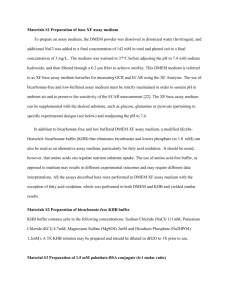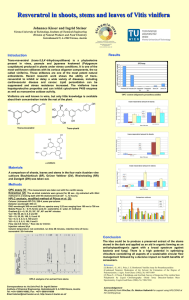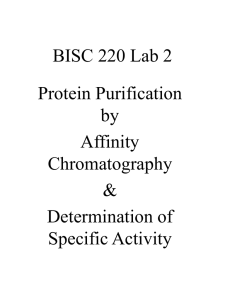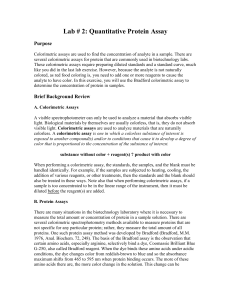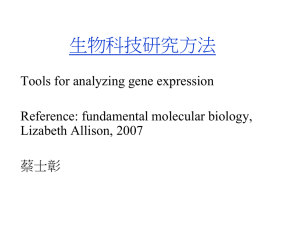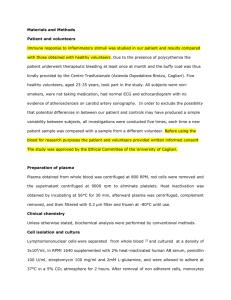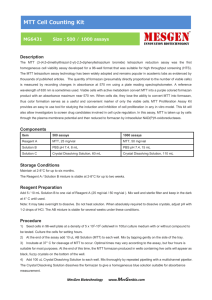Modified Bradford Dye Assay
advertisement
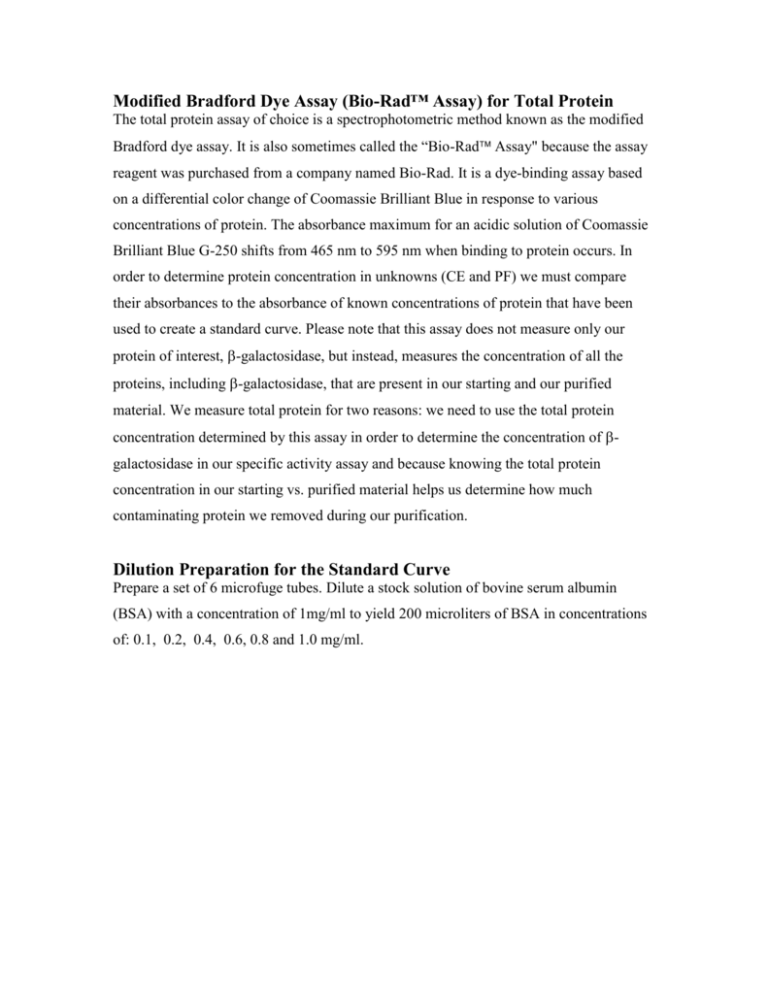
Modified Bradford Dye Assay (Bio-Rad™ Assay) for Total Protein The total protein assay of choice is a spectrophotometric method known as the modified Bradford dye assay. It is also sometimes called the “Bio-Rad Assay" because the assay reagent was purchased from a company named Bio-Rad. It is a dye-binding assay based on a differential color change of Coomassie Brilliant Blue in response to various concentrations of protein. The absorbance maximum for an acidic solution of Coomassie Brilliant Blue G-250 shifts from 465 nm to 595 nm when binding to protein occurs. In order to determine protein concentration in unknowns (CE and PF) we must compare their absorbances to the absorbance of known concentrations of protein that have been used to create a standard curve. Please note that this assay does not measure only our protein of interest, -galactosidase, but instead, measures the concentration of all the proteins, including -galactosidase, that are present in our starting and our purified material. We measure total protein for two reasons: we need to use the total protein concentration determined by this assay in order to determine the concentration of galactosidase in our specific activity assay and because knowing the total protein concentration in our starting vs. purified material helps us determine how much contaminating protein we removed during our purification. Dilution Preparation for the Standard Curve Prepare a set of 6 microfuge tubes. Dilute a stock solution of bovine serum albumin (BSA) with a concentration of 1mg/ml to yield 200 microliters of BSA in concentrations of: 0.1, 0.2, 0.4, 0.6, 0.8 and 1.0 mg/ml. Table 2 Dilution of Stock BSA to make protein standards for total protein assay Tube # BSA Concentration Z Buffer in μL Stock BSA 1 0.1 mg/ml 2 0.2 mg/ml 3 0.4 mg/ml 4 0.6 mg/ml 5 0.8 mg/ml 6 1.0 mg/ml The diluent will be Z-buffer (60mM Na2HPO4, 60mM NaH2PO4, 1mM MgSO4, 0.27% beta-mercaptoethanol) and the final volume needed is 200 l. The formula C1 x V1 = C2 x V2 should help you. Check with your instructor to confirm your dilution strategy in the table above before making these working concentrations of the standards. Remember to add the smaller volume to the larger volume. Dilution Preparation of Unknowns: Dilute your CE and PF 1:5 in Z buffer to yield a final volume of 300 l of each. We are trying to determine the concentration of protein in each but since we don’t know it at this point we will have to use a different dilution formula. sV x df = ftV Where sV is starting volume (the unknown); df is the dilution factor (5); ftV is the final total Volume (300l). Check your dilution strategy with your instructor before making the dilutions. Amount of Z-buffer required = ? Amount of CE or PF required = ? Total Protein Assay Protocol: 1. Label a set of 11 glass tubes. See Table 4 below for the contents of each tube. Put the Protein Assay Reagent into all tubes last. Cover the tubes with parafilm and mix well by vortexing. Table 3. Modified Total Protein (Bradford Dye or BIO-Rad)Assay Protocol Tube # 1 2 3 4 5 6 7 8 9 10 11 12 BSA Standards Diluted in Z-buffer 0.1 100 µl 0.2 100 µl 0.4 100 µl 0.6 100 µl 0.8 100 µl 1.0 100 l - CE unknown 100 µl of the 1:5 dilution in Z-buffer 100 µl 100 µl - PF unknown 100 µl of the 1:5 dilution in Z-buffer 100 µl 100 µl ZProtein Buffer Assay Reagent ™ (Coomassie) 5ml 5ml 5ml 5ml 5ml 5ml 5ml 5ml 5ml 5ml 100 µl 5ml 100 µl 5ml 2. Let the reactions and blanks incubate at RT for a minimum of 15 minutes. The reaction is stable for one hour. 3. You can start making your dilutions or set up your assay tubes for the specific activity assay while you are waiting for the total protein assay to maximize its absorbance shift. 4. After maximum color development (at least 15 minutes but not more than one hour) mix all 11 tubes again and transfer enough of the contents of each assay tube or blanks to a set of labeled 1.5mm plastic cuvettes so that the cuvettes are at least 2/3 to 3/4 full. Check to be sure that there is no precipitate interfering with light passage. If so, let the precipitate settle to the bottom before reading absorbance. 5. Follow the directions for reading absorbance using the Hitachi spectrophotometers. Set the wavelength to 595nm. 6. Blank the spectrophotometer using the reagent blank(s) (tubes 10, and or11). 7. Read A595 for all tubes and record in your lab notebook. Tubes 1-6 (the diluted BSA standards) contain known concentrations of protein. You will use those known concentrations and absorbances to create a standard curve and linear regression line using Excel. The creation of a standard curve will allow calculation of the protein concentration in mg/ml from the absorbance of the diluted CE and PF. Make sure your R2 value for the line is at least .95. The CE and PF have been assayed in duplicate, therefore, the concentrations can be averaged if the replicates are within 10% of each other. Record the total protein concentration for both the CE and the PF in your lab notebook. Remember that the true concentration will be 5 times the value obtained from your linear regression formula since the assay used a 1:5 dilution. Make sure that the 1:5 dilution was appropriate before proceeding to the specific activity assay. If it was, the absorbance readings will be within the range of concentration of the standards used to create the standard curve. If the standards were diluted properly, they will give an absorbance reading within the accurate range of the spectrophotometer (0.1-1 A for the Hitachi specs). If your absorbance readings are outside this range, you will have to repeat the assay using different dilutions in order to obtain an accurate total protein concentration for your CE and PF. The protein concentration of the PF and CE will be used to convert absorbance to specific activity units in the following assay for determining how much beta-galactosidase there is the purified fraction and in the starting material from which it was made (CE). Knowing total protein concentration and the specific activity of beta-galactosidase in the CE and PF will allow us to determine the success of our affinity chromatography purification. DO NOT DISCARD ANY OF THE CRUDE EXTRACT OR PURIFIED FRACTION!

